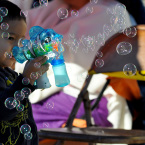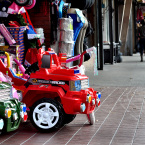Culture Across the Border

Kids enjoy the life in the border.
Located in the southwest, El Paso, Texas represents the cultural mixture at the borderline between Mexico and The United States. El Paso’s population is characterized for its hospitality and simple ways of life different to many other regions of the country.
Most of the American festivities and celebrations in the area are composed of different elements from the American and Mexican culture; from the food to the music.
The most recent celebration was Thanksgiving. For this holiday, El Pasoans prepare a parade where schools and local businesses participate. During this event it is remarkable how the Mexican-american culture grows strong in the area. Unlike past generations there is no “Chicano,””Mexican” or “American” but rather a balance between the roots and future of this community.
Another strong aspect from this area is the mutual support that the city receives and brings to the neighboring city of Juarez.
Commerce is positively impacted by the shoppers that come from the other side of the border to buy presents and other products that are offered at a better price in the US.




















You can make good images. This is your strength.
Your story idea is coherent.
The story is complex, though, and I’m not sure exactly what the core idea is? Is it that El Paso is a place that “there is no “Chicano,””Mexican” or “American” but rather a balance between the roots and future of this community” as you state? If so, how are you showing the balance? Then you work in the “commerce” idea by -I think- showing a shopping area (is it south El Paso Street?), but that’s a different idea than the “cultures blending. ” That is an idea and not visually shown here.
How could you complete this idea?
So, what do we have?
A parade with wonderful characters and good photographs of them (but not so different than any parade anywhere, right?) and a shopping area.
How could you complete this idea?
I’m hard put to be able to answer that. And I’m not the first person who has been stumped when trying to describe the weird culture of El Paso. Is it Latino? Is it Anglo? Is it Latino-Anglo? Is it neither but rather a border culture of its own? Iw it Mexicano? Is it Mexican-American? And if you could come up with a clear answer to that how would you show it?
There have been many many dissertations done by aspiring historians, sociologists, journalists and others trying to answer that question and, in the end, the best they can do, in my opinion, is just to add to the literature, to the data, to the commentary, no one having arrived at a definitive conclusion.
As I said, this was a complex idea and one that takes a lot of time -on the street pecking away at it, shooting, interviewing, learning from what you shot and going at it again.
You tried and this is, in the end, a good start. But, you needed to put a little more street time into this. Remember, we’re doing a National Geographic piece and that’s always about depth. A little more shooting and you’d have a little more depth.